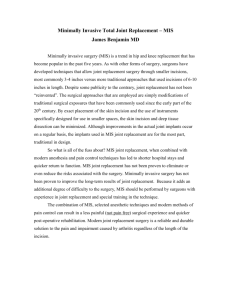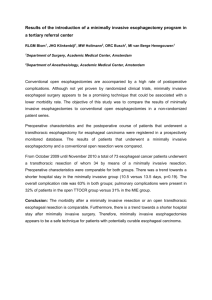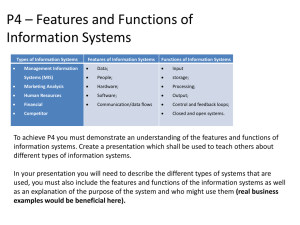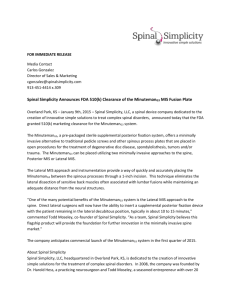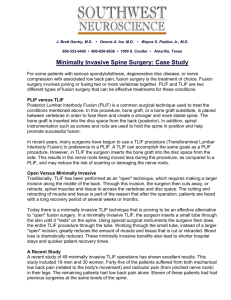Handout - Todd Swanson MD
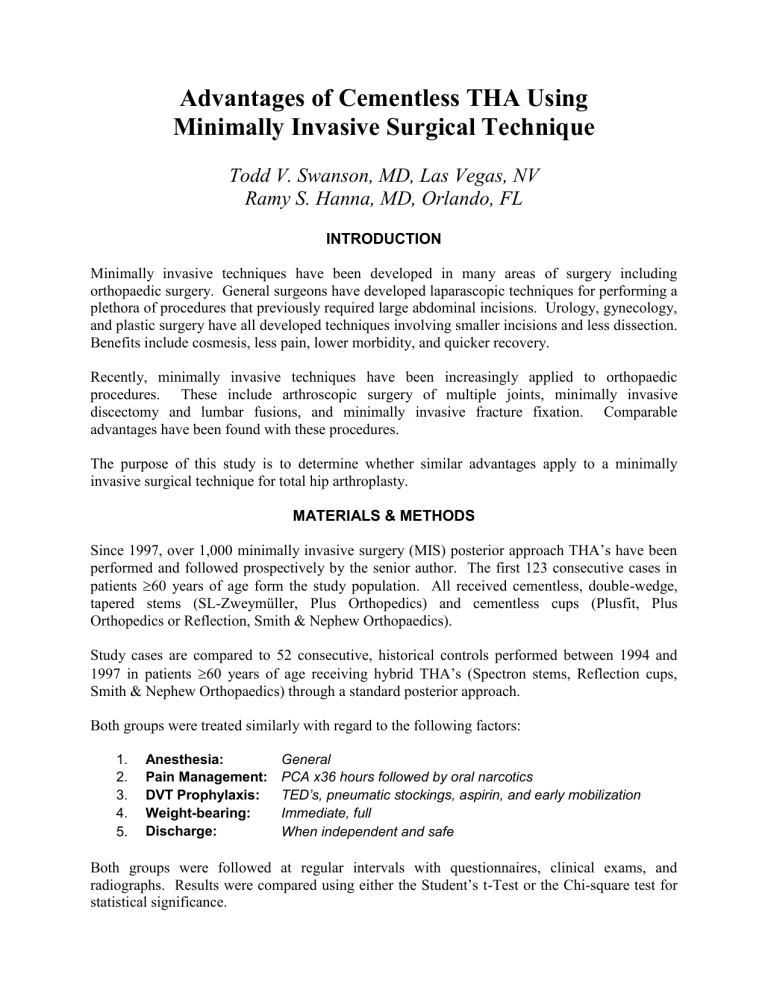
Advantages of Cementless THA Using
Minimally Invasive Surgical Technique
Todd V. Swanson, MD, Las Vegas, NV
Ramy S. Hanna, MD, Orlando, FL
INTRODUCTION
Minimally invasive techniques have been developed in many areas of surgery including orthopaedic surgery. General surgeons have developed laparascopic techniques for performing a plethora of procedures that previously required large abdominal incisions. Urology, gynecology, and plastic surgery have all developed techniques involving smaller incisions and less dissection.
Benefits include cosmesis, less pain, lower morbidity, and quicker recovery.
Recently, minimally invasive techniques have been increasingly applied to orthopaedic procedures. These include arthroscopic surgery of multiple joints, minimally invasive discectomy and lumbar fusions, and minimally invasive fracture fixation. Comparable advantages have been found with these procedures.
The purpose of this study is to determine whether similar advantages apply to a minimally invasive surgical technique for total hip arthroplasty.
MATERIALS & METHODS
Since 1997, over 1,000 minimally invasive surgery (MIS) posterior approach THA’s have been performed and followed prospectively by the senior author. The first 123 consecutive cases in patients
60 years of age form the study population. All received cementless, double-wedge, tapered stems (SL-Zweymüller, Plus Orthopedics) and cementless cups (Plusfit, Plus
Orthopedics or Reflection, Smith & Nephew Orthopaedics).
Study cases are compared to 52 consecutive, historical controls performed between 1994 and
1997 in patients
60 years of age receiving hybrid THA’s (Spectron stems, Reflection cups,
Smith & Nephew Orthopaedics) through a standard posterior approach.
Both groups were treated similarly with regard to the following factors:
1. Anesthesia: General
2. Pain Management: PCA x36 hours followed by oral narcotics
3. DVT Prophylaxis: TED’s, pneumatic stockings, aspirin, and early mobilization
4. Weight-bearing:
5. Discharge:
Immediate, full
When independent and safe
Both groups were followed at regular intervals with questionnaires, clinical exams, and radiographs. Results were compared using either the Student’s t-Test or the Chi-square test for statistical significance.
All cases included in the study have minimum 24-month follow-up (24-96 months). Twentythree cases in the study group and two cases in the control group were excluded due either to death or loss to follow-up prior to the minimum follow-up period, leaving 100 MIS and 50 standard incision patients as the basis for this study.
RESULTS
There were no differences in mean age, weight, diagnoses, Dorr Bone Types, or Charnley
Functional Classes between the two groups. Mean pre-op and final follow-up Harris Hip Scores were similar between the two groups (MIS: 26
87; Standard: 28
83). Advantages of MIS over the standard incision approach included:
Anesthesia Time
Intra-Op Blood Loss
“Problem Pain”
(Deviation from Protocol)
Hospital Stay
Return to Full Activities
Overall Complication Rate
MIS
50 minutes
285 milliliters
0%
4.0 days
6.2 weeks
13%
Standard
83 minutes
487 milliliters
12%
5.4 days
12.9 weeks
24% p-value
<0.0001
<0.0001
<0.0001
<0.0001
<0.001
0.09
Specific complication rates included the following:
Deep Infection
Superficial Infection
Wound Healing Problems
VTE (DVT/PE)
Dislocation
Nerve Palsy
Post-Operative Confusion 4%
Acetabular Loosening 0
Femoral Loosening
Other
0
2%
MIS Standard p-value
1% 0 NS
1% 0 NS
0
1%
3%
1%
0
2%
2%
0
--
NS
NS
NS
12%
0
0
8%
0.06
--
--
--
Component positioning was accurate and reproducible using the MIS technique:
MIS Standard p-value
Acetabular Abduction <30
or >55
4% 2% NS
Acetabular Anteversion <0
or >30
1%
Femoral Stem Varus >5
0
2%
0
NS
--
CONCLUSIONS
Minimally Invasive THA using cementless fixation has several advantages over standard posterior incision THA using hybrid fixation. Whether these advantages are due to the MIS approach, cementless fixation, or a combination of the two remains to be determined.
Development of new instrumentation and better surgical technique provides excellent visualization, minimal skin retraction problems, and accurate component placement. To date, we have performed this procedure in over 1000 patients and have found the technique to be accurate, reproducible, and advantageous to both patient and surgeon.
